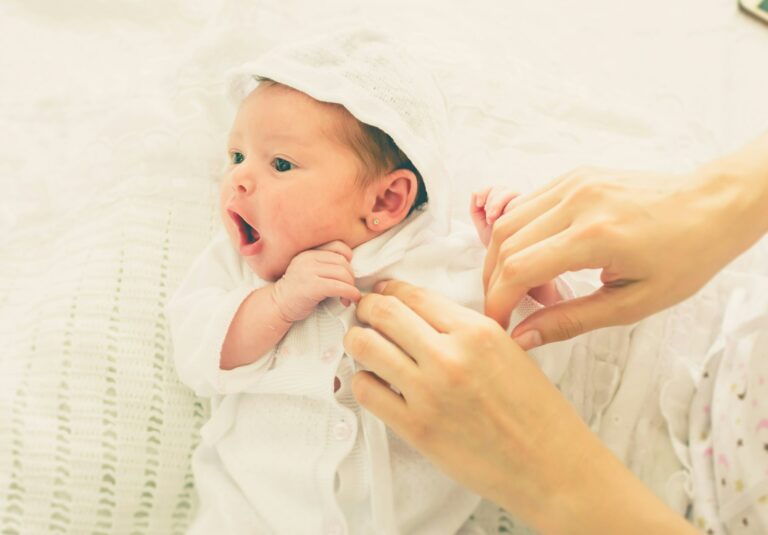From those first sleepless nights to the haze of 2 a.m. feedings, sleeping with a newborn invites a cascade of questions, hopes, and uncertainties. Should the little one curl up by your side or settle safely in a crib just within arm’s reach? The subject often sparks passion and anxiety in equal measure. Many parents—perhaps you as well—lie awake, wondering: is my baby’s sleep environment really secure? Is room sharing more than just a modern trend? When a newborn’s cries break the silence, what is the most reassuring response?
The days and nights blur together, yet your desire to create the safest, most nurturing environment remains unwavering. Here, discover practical strategies for sleeping with a newborn, explore medical explanations behind those unpredictable sleep cycles, learn what science recommends for safe sleeping arrangements, and understand where tradition, emotion, and science intersect. Let’s untangle the doubts and bring you clarity—one night at a time.
Why Newborn Sleep Is So Unique
Newborns live in a world where the concept of “night” or “day” simply hasn’t registered yet. Their sleep, intentionally scattered and short-lived—sometimes as little as 20 minutes, rarely more than an hour in a single stretch—reflects the raw reality of an immature circadian rhythm. Imagine a symphony played in bursts: short periods of REM (rapid eye movement) sleep, where tiny bodies twitch and breathing becomes irregular, interspersed with longer, quieter intervals that might lull parents into thinking a longer rest is on the horizon.
Why this chaos, you ask? At birth, the hypothalamus and pineal gland, which help regulate circadian rhythms and melatonin production, are not fully operational. As a result, newborn sleep patterns—often called polyphasic sleep cycles—remain fragmented, making night wakings and naps virtually indistinguishable. Most newborns require 14 to 17 hours of sleep per 24 hours, yet these hours scatter throughout day and night, driven by hunger cues and not any kind of clock.
You might notice subtle sleep cues—arching back, fussiness, or averting gaze. These often precede full-blown crying. Recognizing them early? That can make nighttime smoother, transforming chaos into calm.
Sleeping with a Newborn: Balancing Tradition, Attachment, and Science
The practice of sleeping with a newborn—in all its forms—often lies at the intersection of ancestral customs and modern science. Room sharing, co-sleeping, and bed-sharing: each term signifies something very specific, and the stakes for safety can be high.
Building the Optimal Sleep Space
Picture this: a firm, flat mattress, a safety-certified crib or bassinet, with only a fitted sheet keeping things tidy. Soft blankets, plushies, and pillows—however adorable—pose risks, not just distractions, and are best avoided. Babies overheat easily, so lightweight sleepwear and a wearable blanket often strike the right balance between coziness and safety.
The American Academy of Pediatrics (AAP) stands firm: keep your newborn in the same room, but in a separate sleep space for at least six months—ideally up to the first birthday. This arrangement, known as room sharing, does more than simplify midnight feeds—it can actually halve the risk of Sudden Infant Death Syndrome (SIDS). The reasons behind this recommendation? Parents can respond faster to needs, monitor subtle changes in breathing, and, perhaps most importantly, create an environment where the infant’s airway remains clear and the bedding hazard-free.
The Risks and Rewards: Room Sharing Versus Bed Sharing
You may have heard many voices extolling the virtues of bed sharing: close contact, effortless breastfeeding, and profound bonding. Indeed, certain cultural traditions consider it the foundation of healthy attachment. Yet, the scientific evidence tempers this view. The risk of SIDS, suffocation, and entrapment increases, especially if parents smoke, use sedatives, or sleep on soft surfaces. Sofas, armchairs, thick comforters—all are less forgiving than any crib and should be avoided entirely.
However, room sharing—giving your newborn their own safe sleep space within arm’s reach—seems, for many, a “middle path.” Parents can comfort, feed, and observe without exposing their baby to unnecessary hazards.
If You Do Decide to Bed-Share…
Despite clear recommendations, some families still choose bed sharing for various reasons—practical, emotional, or cultural. If so, prioritize these safety measures:
- Use a firm sleep surface, never a waterbed or sofa.
- Remove all pillows, stuffed animals, and loose bedding.
- Ensure neither parent has consumed alcohol, sedatives, or other substances that could reduce alertness.
- Always position baby on their back.
- Keep the baby’s face and head uncovered.
Above all, if there is any doubt or discomfort, consult your pediatrician before you settle into a routine.
The Physiology and Practicality of Newborn Sleep Cycles
A newborn’s sleep-wake rhythm is governed by two powerful forces: hunger and neurological development. The rapid growth of the central nervous system requires frequent feeds, driving those relentless night wakings. Compared to adults, whose sleep cycles stretch to 90 minutes, newborns oscillate between light and deep phases in 40–60 minute intervals.
Sleep deprivation for parents is more than just an inconvenience; disrupted REM cycles can elevate cortisol, the so-called “stress hormone”. Over time, this may lead to mood swings, impatience, and forgetfulness—the opposite of what exhausted new parents hope for.
To support brain development, prioritize sleep hygiene:
- Keep daytime bright and active; keep nights dim and quiet.
- Use white noise for calming effects, gently reinforcing night as a time for rest.
- Swaddle safely if your baby is not yet rolling, to soothe the startle reflex.
The Emotional Landscape: Navigating Parental Exhaustion and Anxiety
Parenthood often feels like a marathon with no mapped-out finish line. You might find yourself stuck in a loop of night wakings, endless feeding sessions, and the unpredictable chaos of a newborn’s early days. The emotional toll can be significant.
What helps? Accept help (even a hot meal can create a moment of calm). Limit social visits to avoid overstimulation—for you and your newborn. Trust that some days will defy your best-laid plans and that’s absolutely normal.
Simple rituals—a warm shower, soft music, a few deep breaths—sometimes bring rest for both mind and body. And yes, those old clichés about “sleeping when your baby sleeps”? Frustrating but, often, the best advice.
Perspectives on Sleeping with a Newborn: Tradition, Modernity, and Choice
The decision about sleeping with a newborn rarely fits into one neat box. Room sharing is often promoted for safety, but bed sharing persists in many cultural and family traditions. While science leans toward caution, the lived experience of a parent—struggling through fatigue or in need of closeness—can’t be dismissed.
When making choices:
- Lean on medical guidelines for safety.
- Adapt advice to your household, sleeping arrangements, and needs.
- Evaluate frequently—needs shift as newborns grow and mature.
Practical Tips for Optimising Sleep for Parents and Baby
Establish Gentle Routines
- Bathe baby in warm water before bed.
- Dim the lights, lower ambient sounds.
- Notice early sleep cues and respond before overtiredness sets in.
Feeding and Nighttime Care
- Night feeds should be quiet and brief.
- If bottle-feeding, partners and relatives can share duties.
- For breastfeeding, keeping baby nearby reduces the effort of nightly sessions.
Handling Sleep Issues
Colic, gas, and frequent waking can upend even the calmest households. Techniques like gentle rocking, massage, or the soothing hum of a fan help some babies settle. If concerns about poor weight gain or inconsolable crying arise, reach out to a medical professional promptly.
The Gradual Transition: Adapting Sleep Strategies as Baby Grows
As your newborn’s sleep consolidates—longer stretches, fewer wakings—you may notice readiness for more independent sleep. Gently place your child into the crib while drowsy but still awake. Encourage self-soothing when developmentally appropriate, but never push before four to six months unless advised by your pediatrician.
Gentle sleep training: gradually increase intervals between your check-ins or employ soft words from the doorway. Never compromise on safety—back sleeping, clear cot, no heavy blankets.
Key Takeaways
- Room sharing in a safe environment dramatically reduces risk of SIDS while supporting responsive parenting and breastfeeding.
- Sleeping with a newborn is marked by unpredictable wakes and short sleep cycles; patience and planning smooth the experience.
- Consistency in routines and attention to safe sleep practices lay the groundwork for healthy habits as your child grows.
- The wellbeing of parents is just as important—lean on support systems, share night duty, and rest when possible.
- Flexibility and observation: what works for one family or one child may not fit another. Adapt, reevaluate, and consult with medical professionals.
- For further assistance, download the application Heloa to access personalized advice and free health questionnaires for your child—tailored support whenever you need it.
Questions Parents Ask
How long should a newborn sleep in your room?
Most health authorities recommend that your newborn stays in the same room as you—on a separate sleep surface—ideally for the first six to twelve months. This setup provides a balance of safety and convenience, making nighttime care less taxing for parents and offering protection against sleep-related risks.
What is the safest position for a newborn to sleep in?
Placing your newborn on their back to sleep is considered the safest and most protective position against SIDS. The sleep surface should be flat, firm, and completely free from soft toys, pillows, and bulky bedding. It helps to keep the baby’s head and face uncovered.
Can you safely co-sleep or bed-share with a newborn?
While room sharing is recommended, bed sharing carries an increased risk of SIDS, suffocation, or entrapment. If you still opt for bed sharing, ensure strict safety measures: use a firm mattress, remove all loose bedding, and never bed-share under the influence of alcohol, medication, or if you smoke. For most, a bedside crib or bassinet offers the intimacy of co-sleeping with fewer risks. Discuss your specific situation with your pediatrician to decide what’s best for your family.
Further reading:









